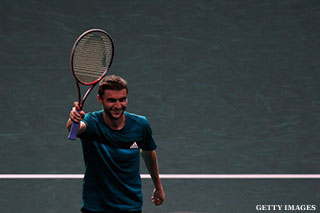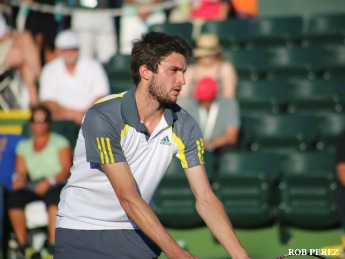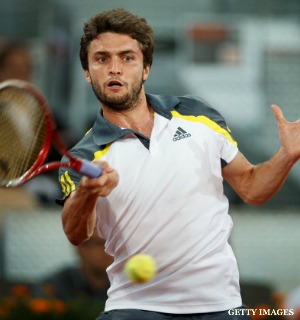
I may not be facing off against the pros, but there are times when I step onto a tennis court, ready for battle, and upon meeting my opponent, the obvious becomes, well, obvious.
My opponent is bigger than me. He is stronger than me. He hits a much bigger ball than me.
The question is: What can I do to win?
I asked someone who does this for a living.
That's right. Someone puts food on his table by stepping onto a tennis court, playing guys bigger than him, guys stronger than him, guys who hit balls exponentially harder than him ... and beating them.
How big are these giants? Rafael Nadal is listed at 6-1 and 188 pounds. Tomas Berdych clocks in at 6-5 and 205 pounds. Juan Martin Del Potro is a cool 6-6 and 214 pounds. I think it's fair to say that these men hit the biggest balls in the history of the sport.
And then there is Gilles Simon.
After cracking the top ten in 2008, he's settled into a rankings position between ten and fifteen in the world.

And he does it at clocking in at barely six foot and 154 pounds.
This diminutive figure with a slight frame has wins over every single person in the top ten. Yes. I'm talking about Djokovic, Federer, Murray, Nadal. You know ... the top ten.
The French media frequently refer to Simon as "fantastique!" It's almost as if they're talking about a magic trick, a sleight of hand, an illusion. Because it should not be. It cannot be. And yet ... there he is. Season after season. Year after year. Gilles Simon is among the very best in the world.
So what is he doing out there?
Simon can hit the ball with pace. He can hit winners. He can finish points. But he readily admits he will never hit the ball as big as most of his opponents. This isn't an opinion; it's physics.
I had the opportunity to sit down and chat with Simon. These are his keys to victory -- and maybe yours too.
"If I try to hit like them, I will lose."
Simon's game plan begins with letting go of his ego. He admits to himself and his opponent that he will lose the slugfest. His opponent does this better than he does. So he does something else.
"I have to notice things on the court," he says. "I have to see where I have to be aggressive, where the guy's gonna miss. It's harder for me to find the good way to win the point."

Mark Knowles, a veteran who has competed against him, said Simon has one of the highest tennis IQs on tour. According to Knowles, Simon plays points to test his opponents, see what they like and, more importantly, to see what they don't. Sometimes it takes him a whole match to find out what makes you uncomfortable, but when he does, his opponents will start to feel like they're in "Groundhog's Day" because they're playing -- and mostly losing -- the same point. Over. And over. And over.
"Early in a match is harder for me," Simon said. "But when the match goes for one hour thirty, two hours, and he starts to feel like when he goes for the winners ... I'm there. And he has to work more and more ... it's harder for him."
Just what does Simon do that makes it harder for his opponents over the course of the match?
He absorbs power.

Most guys are out there trading punches, trying to knock down the other guy.
But Simon does something else entirely. Announcers call him "the human backboard" because he gets everything back, but I think he's more like a human trampoline. There is elasticity in his reply. It's as if Simon takes all the pace off the ball and then gives it back.
This means shot after shot, game after game, hour after hour, Simon's opponents must generate all the pace while Simon sits backs and uses theirs so he expends less energy than his opponents.
"I have a good control of the court," he added. "When I play a shot I most of the time know already where a ball is going to come back after."
Simon recognizes what his opponent likes to hit, especially under pressure. As the match goes on, he makes sure he's there waiting for that ball. His opponents know Simon is going to be there so they start to go for a little bit more. They hit it a little bit harder, maybe a little closer to the lines. Or, often, they just start to hit a different shot altogether.
But understand what's happening here. His anticipation puts pressure on his opponents and forces them out of their comfort zone.
"If the guy has a huge forehand, I will be able to touch his backhand from any part of the court," he said.
Another advantage: Notice how Simon says he is going to "touch" his opponent's backhand. He doesn't have to attack their backhand. He doesn't have to break it down or hit through their weaker side. All Simon has to do is "touch" it. This is enough. This forces his opponents to beat him without their weapon.

Simon does this in a variety of ways. He can hit short, soft angles, putting opponents in an awkward place on the court. He can hit deep to the corners, neutralizing the point. But my personal favorite is perhaps the most cunning. Simon plays low, often without pace, down the middle of the court.
The play gives opponents nothing to work with, nothing to sink their teeth into. The ball has no pace so it forces them to generate. The ball is below the net so they can't attack it comfortably. The ball is in the middle of the court so they have no angles. Of course the depth of this ball varies, but usually it's not short enough to come in off of, but it's not deep enough to stay back and grind. Come forward? Stay back? Arguably the least practiced and therefore most vulnerable part of the modern game is the transition game. And to beat Simon that's what opponents have to do. All. Day. Long.
Simon slays giants with his head, with his anticipation, with his patience. But Simon does this not over the course of a point or a game or a set, but a match.
Some people construct points. Gilles Simon does the same thing except with matches.
Next time you're on the court with someone bigger than you, why not try to do the same thing?
-- Rob Perez is a writer for screen and television whose credits include "40 Days & 40 Nights." He is a passionate tennis fan, player and periodic coach.




